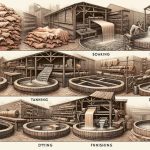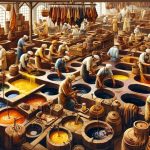No, I'd say leather isn't really a type of fabric. While folks often lump them together because they're both used in making clothes and accessories, they come from totally different sources and processes. Leather is crafted from animal hides through a process called tanning, which gives it that durable and water-resistant quality. On the other hand, fabric usually involves weaving or knitting fibers together—think cotton or polyester. Leather has its own unique properties and that distinct, classic look. It's a special material all its own. Curious about how leather stands out even more? Stick around, and I'll show you!
Table of Contents
Key Takeaways
- Leather is produced from animal hides through a tanning process, distinguishing it from woven or knitted fabrics.
- Unlike fabric, which is typically made from plant or synthetic fibers, leather is a natural material derived from animal skin.
- Leather undergoes specific processes like tanning and crusting for durability and water resistance, not typical in fabric production.
- The unique properties and aesthetic of leather, such as its texture and insulative characteristics, set it apart from conventional fabrics.
- Leather and fabric are used differently in various industries, with leather being more prevalent in luxury goods and durable items.
Defining Leather and Fabric
To clear things up, let's define leather and fabric: leather is made from animal hides through tanning, whereas fabric is typically created by weaving or knitting fibers.
Now, diving deeper into these materials, leather's origins from animal hides make its production quite unique. Unlike conventional fabrics that rely on plant or synthetic fibers, leather requires a specific tanning process to transform hides into durable, water-resistant materials with a distinctive texture.
This difference in the production process highlights why leather stands out. While fabrics are often praised for their versatility and adaptability, leather is celebrated for its durability and functional properties such as enhanced water-resistance. Moreover, the texture of leather gives it a unique aesthetic appeal that's hard to replicate with conventional fabrics.
Understanding these distinctions helps clarify why leather isn't classified as a conventional fabric. It's a specialty material with properties and a production process that set it apart from the more commonly understood fabrics made from interlocking fibers. So, when you're considering materials for anything from fashion to furniture, remembering these fundamental differences can guide your choices more effectively.
The Leather Production Process
Let's dive into how leather is made, starting with the initial stages of preparation and moving through to drying and finishing. First, animal hides are carefully selected and preserved. This is where skilled craftsmanship kicks in right from the start—ensuring only the best hides move forward.
Next, we enter the tanning phase, a crucial part of the leather production process. Here, tanning methods like vegetable tanning and chrome tanning come into play. Vegetable tanning uses natural materials and is known for producing durable, eco-friendly leather. On the other hand, chrome tanning is quicker and gives the leather a more supple finish.
Once tanned, the crusting process begins. This involves thinning, lubricating, and possibly dyeing the leather before it's finally dried and finished. Each of these steps demands meticulous quality control to maintain high leather quality. Every phase, from tanning to finishing, is monitored to meet strict standards.
The finishing techniques applied at the end can enhance the leather's properties, such as making it water-resistant or giving it a glossy sheen. This stage highlights the importance of detailed workmanship in achieving the luxurious feel and high quality that premium leather is known for.
Common Uses of Leather
After exploring how leather is crafted, I'll now look at the many ways it's used in everyday items. From stylish apparel to essential accessories and even in our homewares, leather goods are everywhere! Its popularity isn't just about looks; the durability and insulative properties of leather make it an ideal choice for numerous applications.
Leather jackets and boots are just the tip of the iceberg. We also see leather embraced in accessories like belts and wallets which benefit from its strength and longevity. Each piece showcases the unique characteristics of different types of leather, such as top-grain, split, or reconstituted, tailoring each item to specific needs and styles.
Even in homewares, leather proves indispensable. It's not just about plush leather couches but also extends to durable automobile seats and even the binding of those vintage books on your shelf. Here's a quick breakdown of leather's uses across various categories:
| Category | Examples | Leather Type Used |
|---|---|---|
| Apparel | Jackets, boots | Top-grain, split |
| Accessories | Belts, wallets | Top-grain, reconstituted |
| Homewares | Couches, automobile seats | Split, reconstituted |
This versatility and the enduring appeal of leather ensure it remains a staple in both fashion and functionality.
Comparing Costs: Leather Vs Fabric
Often, when comparing the costs of leather to fabric, you'll find that leather generally runs pricier due to its quality and production processes. When diving into the specifics, it's clear that not all leather and fabric are created equal, and their costs reflect this diversity. Let's break it down:
- Top-Grain Italian Leather: Known for superb quality, this leather's pricing is on the high end, reflecting its luxurious origin and meticulous processing.
- Exotic Leather: Options like crocodile or ostrich spike in price due to their rarity and the complex methods required to process them.
- Industrial Fabric: Typically less expensive than high-end leather, these fabrics are more uniform in production and widely available.
- Quality and Origin: Both leather and fabric can range from budget-friendly to luxury based on these factors. For instance, standard leather or basic cotton might be affordable, but the leap to premium Italian leather or fine silk shows a significant cost increase.
Understanding these differences helps explain why leather often comes with a heavier price tag. It's not just about the material itself but also where it comes from and how it's made.
Environmental Impact of Leather
When we talk about the environmental impact of leather, a few key issues come up.
First, the emissions from producing leather are pretty significant, not to mention the hefty water use needed for tanning.
Plus, the process can really disrupt wildlife and their habitats, which is something we need to think about.
Leather Production Emissions
Leather production significantly impacts the environment, emitting pollutants like chromium and sulfide. As I've dug deeper, it's clear the process isn't just about these chemicals. Here's a quick hit list to get why this matters:
- Solid Waste & Wastewater: The sheer volume complicates pollution control and waste management.
- Chemical Waste Disposal: Contributes majorly to environmental degradation, with nasty stuff like VOCs released.
- Slow Biodegradation: Leather goods don't break down quickly, piling up environmental issues over time.
- Use of Enzymes: While enzymes like proteases enhance sustainability, they're a double-edged sword in the ecological balance.
It's a complex issue that's more than just dirty water or stinky air; it's about our long-term health and planet's well-being.
Water Usage in Tanning
While we're on the topic of the environmental impact of leather, let's talk about how much water tanning uses. Leather tanning gulps down a staggering 3,000 to 15,000 liters of water per ton of hides. This massive water consumption not only poses severe environmental risks due to the pollutants in the wastewater, like chromium and sulfides, but also contributes to water scarcity in tannery-heavy areas.
Thankfully, the industry is pivoting towards more sustainable practices. Efforts like recycling water, using cleaner technologies, and stricter regulations are making a dent. Vegetable tanning, for instance, shows promise in reducing water use and pollution. These steps are crucial for mitigating the negative impacts and steering the leather tanning process towards a more sustainable future.
Wildlife and Habitat Effects
I've learned that the production of leather has severe consequences for wildlife and their habitats. The environmental toll is massive, impacting both the land and the species that inhabit it. Here's a clear rundown:
- Habitat Destruction: Intensive farming for leather demand leads to significant land conversion, stripping habitats for grazing and feed crops.
- Tannery Waste: Toxic chemicals from tanneries pollute waterways, affecting aquatic life and jeopardizing ecosystem health.
- Methane Emissions: Livestock produce methane, a potent greenhouse gas that contributes to climate change and further disrupts habitats.
- Biodiversity Loss: Hunting endangered species for exotic leathers creates imbalances, threatening the survival of unique wildlife.
This peek into the repercussions makes me reconsider the true cost of leather.
Leather Certifications and Standards
To ensure ethical and sustainable production, various certifications are available for different types of leather goods. It's key to understand that while the USDA and European Commission don't offer organic certifications for leather garments, other certifications step in to fill the gap for those of us keen on sustainable options.
For instance, OEKO TEX certification is a big deal because it backs sustainable leather goods. This means when you pick up a leather item with this label, it's gone through rigorous checks to ensure it's environmentally friendly.
Then there's the Global Recycle Standard (GRS) which is crucial for anyone interested in recycled leather. This certification ensures that the leather products labeled as recycled truly meet strict criteria regarding the content and practices used in production.
Knowing about these certifications helps us make informed decisions. We're not just buying a piece of leather; we're supporting practices that care for the planet. Whether it's OEKO TEX for sustainable production or GRS for recycled leather, these certifications guide us toward ethical choices in leather production, making sure our fashion statements don't cost the earth.
Frequently Asked Questions
Can Leather Be Considered a Fabric?
I'd say no, leather can't be considered a fabric. It's made from animal hides, not woven or knitted like fabric. Its production process and properties really set it apart from traditional fabrics.
What Is Fabric Leather Called?
Fabric that looks like leather is often called 'faux leather' or 'leatherette.' It's made from synthetic materials, providing a cheaper and cruelty-free alternative to real leather in various products.
What Is the Difference Between Fabric and Leather?
Fabric's typically woven or knitted from fibers, while leather's made from animal hides through tanning. They differ in texture, durability, and production, making them distinct in use and characteristics.
Is Leather a Type of Fiber?
No, leather isn't a type of fiber; it's made from tanned animal skins, not woven or knitted like fabrics. It's a distinct material known for its durability and unique texture.
- Does Chiffon Fabric Stink - July 15, 2025
- Does Chiffon Fabric Affect the Economy - July 15, 2025
- Does Cotton Fabric Have a Nap - July 15, 2025







